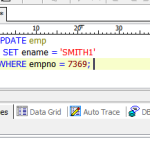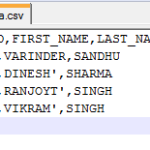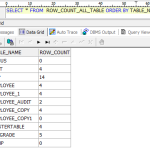Oracle – PL-SQL – Introduction to Cursors
A cursor is basically a set of rows that we can access one at a time.
When we use the cursor, it means we have the select statement that returns the more than one row; we need to access the one row at a time.
Working of Cursors
Basically in the cursors, we retrieve or fetch the rows using SELECT statement into the cursors then retrieve or fetch the row from the cursor one by one. (i.e. fetch one row at a time)
Steps to use the Cursors
- Declare variable to store the value when we fetch the values from the cursor
- Declare the cursor with SELECT statement
- Open the cursor
- Fetch the value from cursor and store in the variable (as we declare the variable in steps 1)
- Close the cursor
Example:
-- CREATE TABLE
CREATE TABLE EMPLOYEE
(
ID NUMBER NOT NULL,
FIRST_NAME VARCHAR2(10 BYTE),
LAST_NAME VARCHAR2(10 BYTE)
);
-- INSERT SOME VALUES INTO TABLES
INSERT INTO EMPLOYEE (ID,FIRST_NAME,LAST_NAME) VALUES (1,'VARINDER','SANDHU');
INSERT INTO EMPLOYEE (ID,FIRST_NAME,LAST_NAME) VALUES (2,'DINESH','SHARMA');
INSERT INTO EMPLOYEE (ID,FIRST_NAME,LAST_NAME) VALUES (3,'RANJOYT','SINGH');
INSERT INTO EMPLOYEE (ID,FIRST_NAME,LAST_NAME) VALUES (4,'VIKRAM','SINGH');
-- SEE THE VALUE IN THE TABLES
SELECT * FROM EMPLOYEE;
-- CURSOR EXAMPLE
DECLARE
V_ID EMPLOYEE.ID%TYPE;
V_FIRSTNAME EMPLOYEE.FIRST_NAME%TYPE;
V_LASTNAME EMPLOYEE.LAST_NAME%TYPE;
CURSOR CURSOR_EMPLOYEE IS
SELECT ID, FIRST_NAME, LAST_NAME FROM EMPLOYEE;
BEGIN
OPEN CURSOR_EMPLOYEE;
LOOP
FETCH CURSOR_EMPLOYEE INTO V_ID, V_FIRSTNAME, V_LASTNAME;
DBMS_OUTPUT.PUT_LINE(V_ID);
DBMS_OUTPUT.PUT_LINE(V_FIRSTNAME);
DBMS_OUTPUT.PUT_LINE(V_LASTNAME);
EXIT WHEN CURSOR_EMPLOYEE%NOTFOUND;
END LOOP;
CLOSE CURSOR_EMPLOYEE;
END;





